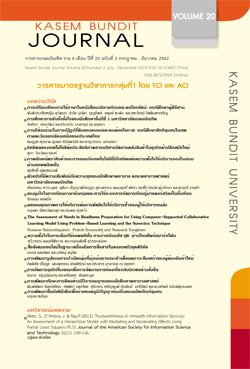The Assessment of Needs in Readiness Preparation for Using Computer-Supported Collaborative Learning Model Using Problem-Based Learning and the Synectics Technique
Keywords:
The Assessment of Need, Computer-Supported Collaborative Learning, Problem-Based Learning, Synectics Technique, Innovative CapabilityAbstract
The purposes of this study were to assess the needs required in readiness preparation for undergraduate students before using the Computer-Supported Collaborative Learning (CSCL) model and using problem-based learning and the synectics technique to enhance undergraduate students’ innovative capability. A questionnaire was used to collect the data. The participants were 400 undergraduate students from private and public universities, using a cluster random sampling technique. The study indicated that most of the undergraduate students spent most of their time on computers and internet usage on entertainment, communication, searching data, education, and downloading data respectively. The highest need was the use of new problem-solving techniques in teaching and learning, followed by the use of brainstorming and learning from the authentic problems, and the use of participation in understanding problems altogether.
References
Azimi, H.M. & Rahmani, R. (2013). Importance of Needs Assessment for Implementation of E-learning in Colleges of Education. International Journal of Information and Computation Technology, 3(5), 377-382.
Balakrishnan, B. (2014). Online Computer Supported Collaborative Learning (CSCL) for Engineering Students: A Case Study in Malaysia. Comput Appl Eng Educ9999, 1-11.
Basadur, M. & Gelade, G.A. (2006). The Role of Knowledge Management in the Innovation Process. Creativity and Innovation Management, 15(1), 45-62.
Bergstrom, C.M., Pugh, K.J., Phillips, M.M., & Machlev, M. (2016). Effects of Problem-Based Learning on Recognition Learning and Transfer Accounting for GPA and Goal Orientation. The Journal of Experimental Education, 84(4), 764-786.
Cress, U., Wodzicki, K., Bientzle, M., & Lingnau, A. (2011). CSCL for intellectually disabled pupils: Stimulating interaction by using a floor control mechanism. International Journal of Computer-Supported Collaborative Learning, 6, 307-321.
Dockter, D.L. (2012). Problem-Based Learning in Accounting. American Journal of Business Education, 5(5), 547-554.
Eng, T.Y. & Okten, D. (2011). Exploring a dynamic framework of innovative capability: a theoretical integration of technological and marketing capabilities. Technology Analysis & Strategic Management, 23(9), 1001-1013.
Gallagher, S.A. (2015). The role of problem-based learning in developing creative expertise. Asia Pacific Education Review, 16, 225-235.
Goggins, S.P. & Jahnke, I. (2013). Computer-Supported Collaborative Learning at the Workplace— Making Learning Visible in Unexpected Online Places Across Established Boundaries. New York: Springer Science&Business Media.
Guide to Conducting An Education Needs Assessment: Beyond The Literature Review. (2009). Retrieved December 28, 2017, from https://www.janssentherapeutics-grants.com/sites/all/ themes/ttg/assets/Needs%20 Assessment%20Guide.pdf.
Hansen, J.D. (2005). Using Problem-Based Learning in Accounting, Journal of Business Education for Business, 81(4), 221-224.
Hayati, A., Bentri, A., & Rahmi, U. (2017). Analyzing the Issues in the Implementation of Authentic Assessment in the 2013 Curriculum. Al-Ta’lim Journal, 24(1), 53-59.
Hummell, L. (2006). Synectics for Creative Thinking in Technology Education. The Technology Teacher, 22-27.
Johnstone, K.M. & Biggs, S.F. (1998). Problem-based Learning: Introduction, Analysis, and Accounting Curricula Implications. Journal of Accounting Education, 16, 407-427.
Joyce, B. et al, (2000) Model of Teaching (6th ed.) MA: Peasant education Company.
Lipponen, L. (2002). Exploring Foundations for Computer-Supported Collaborative Learning. Proceedings of CSCL 2002, 72-81.
Litchfield, B.C. & Dempsey, J.V. (2015). Authentic Assessment of Knowledge, Skills, and Attitudes. New Directions for Teaching and Learning, 142, 65-80.
Manaf ,N.A.A., Ishak, Z., & Hussin, W.N.W. (2011). Application of Problem Based Learning (PBL) in a Course on Financial Accounting Principles. MJLI, 8, 21-47.
Momeni, M., Nielsen, S.B., & Kafash, M. H. (2015). Determination of Innovation Capability of Organizations: Qualitative Meta Synthesis and Delphi Method. In 25th Annual RESER Conference.
Nisula, A.M. & Kianto, A. (2013). Evaluating and developing innovation capabilities with a structured method. Interdisciplinary Journal of Information, Knowledge, and Management, 8, 59-82.
P21's Framework for 21st Century learning website. (2015). Retrieved October, 5, 2017, from http://www.p21.org/our-work/p21-framework
Seligmann, E.R. (2007). Reaching Students through Synectics: A Creative Solution. Retrieved September 22, 2017, from http://www.ellieseligmann.com/essays/ synectics_seligmann.pdf
Stahl, G., Koschmann, T., & Suthers, D. (2006). Computer-supported collaborative learning: An historical perspective. UK: Cambridge University Press, 409-426.
Tajari,T. & Tajari, F. (2011). Comparison of effectiveness of synectics teaching methods with lecture about educational Progress and creativity in social studies lesson in Iran at 2010. Procedia - Social and Behavioral Sciences, 28, 451-454.
The Department of Education, Employment and Workplace Relations. (2009). Developing Innovation Skills: A guide for trainers and assessors to foster the innovation skills of learners through professional practice. Australia: Innovation & Business Skills Australia Ltd.
Tresin, S. (2012). The development of computer supported collaborative learning model for developing problem solving ability of industrial education student. Ph.D. in Education Technology and Communication thesis, Naresuan University, Phitsanulok.
Verdejo, M.F., Barros B., Read T., & Rodriguez-Artacho, M. (2007). Designing a CSCL environment for experimental learning in a distance-learning context. The Role of Technology in CSCL, New York: Springer Science Business Media, 139-153.
Wongwanich, S. (2015). Needs Assessment Research 3rd ed. Bangkok: Chulalongkorn University Press.
Wood, D.F. (2003). ABC of learning and teaching in medicine: Problem based learning. BMJ, 326, 328-330.
Downloads
Published
How to Cite
Issue
Section
License
ทัศนคติ ความคิดเห็นใด ๆ ที่ปรากฏในวารสารเกษมบัณฑิตฉบับนี้เป็นของผู้เขียน โดยเฉพาะ มหาวิทยาลัยเกษมบัณฑิตและบรรณาธิการ ไม่จำเป็นต้องมีความเห็นพ้องด้วย






